

Myrtles Plantation, built in 1796, is one of America’s most haunted places
The Myrtles Plantation offers a unique opportunity to stay in a lovely antebellum mansion on a historic plantation from yesteryear. But its reputation— one of America’s top ten most haunted places— draws those keen on seeing more than period antiques and original furnishings.
For almost 40 years, paranormal groups, television crews and ghost hunters have swooped in with their fancy equipment hoping to capture encounters.
Yet it’s the guests who don’t really believe in ghosts that tend to have the strangest experiences. Causing some to flee from their room in the middle of the night!
My friend Donna and I traveled through Louisiana last November, and spent 2 nights at the Myrtles Plantation. The 10 acre property offers 6 guestrooms with antique furnishings in the original plantation home, plus several cottages spread around the grounds. They include the rustic Caretaker’s Quarters behind the Gift Shop, 6 modern Garden Rooms off the brick courtyard, 4 one bedroom cottages beyond the cypress pond, and Coco House, a 2 bedroom 2 bath home near the restaurant. Rooms fill quickly, even far in advance.
Scary Stuff!
We reserved the Caretaker’s Quarters, where the crew of Ghost Hunters stayed and filmed an episode for their tv show. To be honest, I was a little fearful of staying in the main house after reading the autobiographical account of Frances Keerman, the owner of the Myrtles Plantation from 1980-1990.
Her experiences included many frightening events, from doors locking and trapping her inside her own home, to voices calling her name, heartwrenching sobs, and heavy footsteps. She saw apparitions of Sarah, a floating candelabra coming down the stairs (!), a dancing woman, a crying portrait, an antique wheelchair moving toward her, two little blond girls, the Confederate soldier, and an older black woman hovering over her at night holding a lit candle. But the scariest of all–was seeing her husband temporarily transform into an old woman who was attempting to possess him.
Her book, Myrtles Plantation: The True Story of America’s most Haunted House, was published 15 years after she moved out. It is a fast, fascinating read based on her experiences as she renovated Myrtles Plantation and opened it as an inn. She kept her ghost encounters to herself, leaving her guests in the dark thinking no one would want to stay in a haunted inn. Yet her guests reported so many strange occurrences that soon news reporters and journalists arrived, spreading sensational stories of the hauntings. And it’s been famous ever since!
First Impressions of the Myrtles Plantation
We drove 2.5 hours east across central Louisiana to reach the French Creole northern end of Louisiana’s Plantation Country, where graceful mansions dot the countryside along the Mississippi’s Great River Road that winds all the way south to New Orleans. Passing through the charming village of St. Francisville, we turned off Highway 61 and followed the pretty drive leading to the plantation.

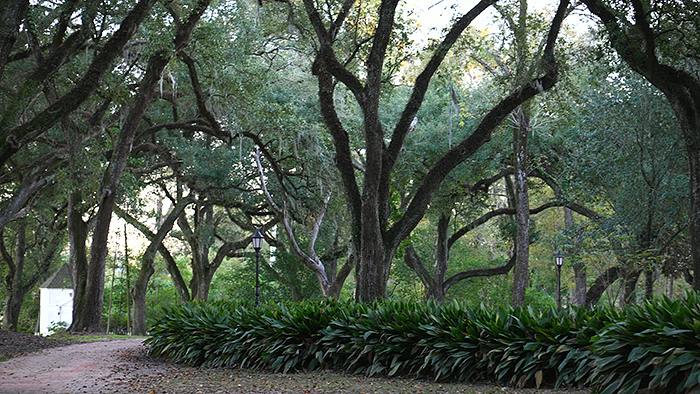
Entrance Myrtles Plantation
Feathery moss dangling from branches under a canopy of Live Oaks fluttered in the breeze, adding a mysterious air to the forested scene. We were definitely in the South! What a beautiful setting. Nestled at the end of the drive was a Grecian statue welcoming guests to the stately antebellum home of Myrtles Plantation just beyond. The two-story mansion had a genteel, graceful appearance.
Twin entrances led up the long wraparound porch trimmed in lacy wrought-iron, painted mint-green. This was the haunted mansion? It looked so feminine and inviting!

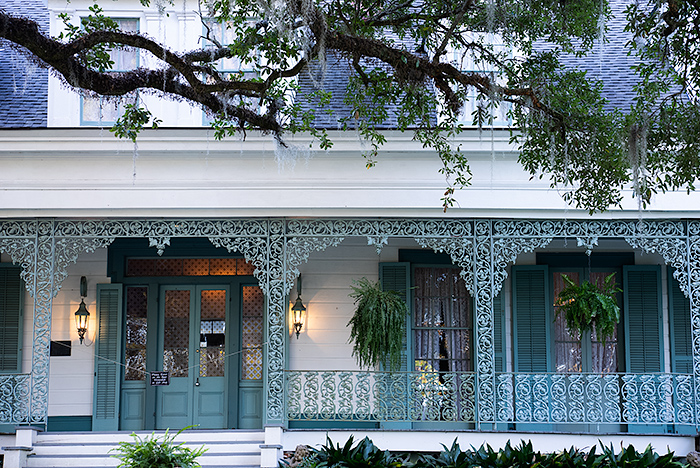
We parked and carried our luggage to the Reception building located behind the plantation home. Two women were relaxing in rocking chairs on the back verandah.
One called out to us as we passed, “Hey, what room did you book?”
“Caretaker’s Cottage,” I answered. The women shared a look and muttered too bad, rather smugly. They went on to boast that they, and all the guests staying in the main house last night, were jolted awake by loud party noises around 3am.
When of course there hadn’t been one.

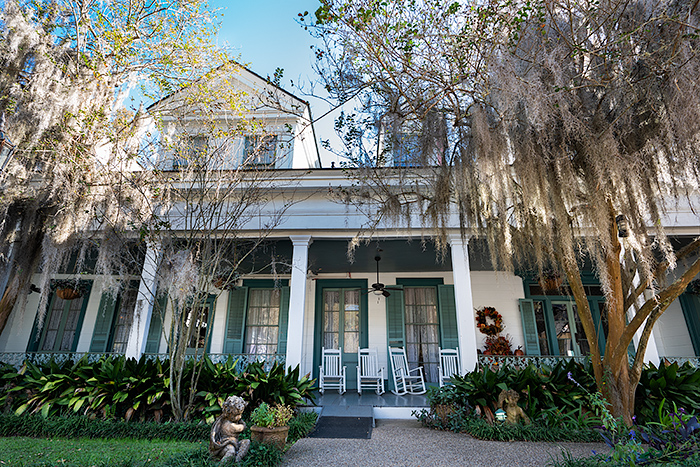
Back verandah of Myrtles Plantation
How cool!! Maybe we’ll get to hear the party tonight too!
I’d read about this. Guests often hear ghostly sounds of a party during the Spring and Fall, seasons when the Stirling family hosted four-day galas in the 1840’s and 1850’s. Myrtles Plantation, Afton Villa and Greenwood plantation were known for having the most elaborate parties of that era.
Previous owners, guests– and even people passing on the road– have reported hearing the parties. Loud lively music, clinking glasses, laughter and muffled conversation drift from the home in the wee hours of the night. The sounds are so real that all but the heaviest sleepers awaken. Sometimes unknowing guests act miffed that they “weren’t invited to the party going on downstairs.”
Day Tours at Myrtles Plantation
Long before the plantation became an inn, travelers would walk up to the front door and request a tour of the home. Today, the tradition continues. Day visitors can join the 45 minute tour for $15 per person, offered between 9:30-4:30 daily. Tickets are complimentary for overnight guests. The tour includes historical infomation about the home and early residents, the legend of Chloe, the slave girl who poisoned Sarah Bradford Woodruff and her young twins in the 1820’s, and the murder of William Winter who died on the 17th stair in the grand entrance hall.
Tourists are led into the French bedroom, the dining room, ladies’ & gentlemen’s parlor and game room– all located on the ground floor. The upstairs is off-limits except for overnight guests who book one of the rooms.

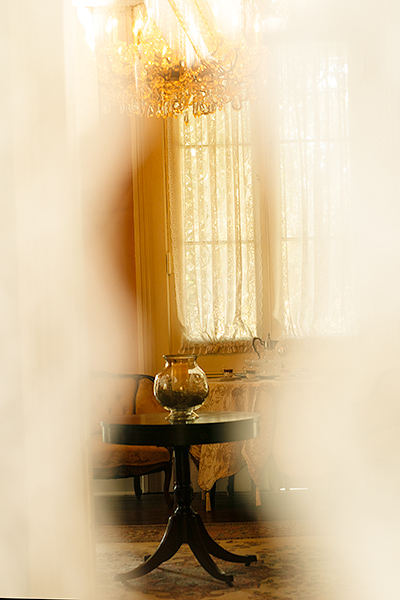
Peeking into the parlor
When we checked in at 4pm, we were offered to join the last tour of the day. Perfect. Turns out we were the only participants. Our guide was a 30ish old blonde who’d been working there less than a year since she lost her cruise job due to the Covid pandemic. She was clearly spooked as she unlocked the doors and led us around. The antebellum mansion was quiet, and empty.
No one resides here any more. The current owners are the first to live off-site.
So walking through the rooms with our guide felt a little like visiting a hushed museum. The entire downstairs of Myrtles Plantation is kept locked up, except for guided tours. Only guests staying in the Woodruff suite have a key to the grand entrance hall where they must climb the red-carpeted stairs to reach their room.
Entrance Hall
Our guide led us into the grand entrance hall and pointed out the haunted mirror. I personally didn’t see the handprints in the glass, but instead saw a profile of a turbaned woman. And claw marks.

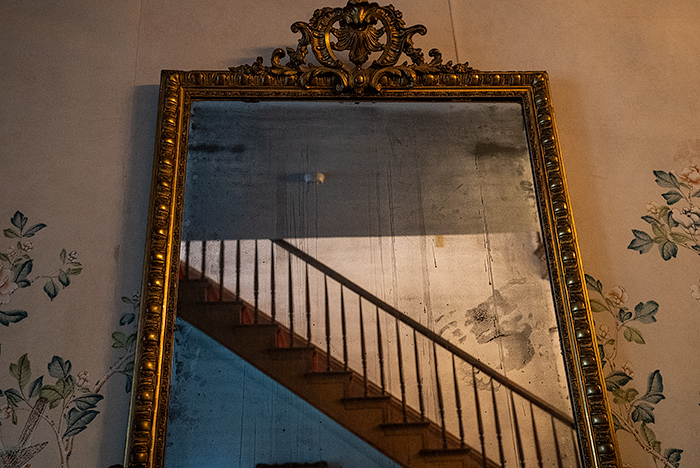 The grand hall is illuminated by the massive 300 lb Baccarat crystal chandelier. Mrs. Stirling bought this from a castle in France after she and her husband Ruffin purchased the Myrtles Plantation in 1834. They spared no expense to create a show-stopper in this Gilded Age. The wallpaper, which looks tired and faded now, took great effort to create. Artists hand-painted single designs on delicate eggshell paper on 12 separate layers, then carefully lined up the fragile transparent papers to add color and depth to the final scene. This French process was expensive and extensive.
The grand hall is illuminated by the massive 300 lb Baccarat crystal chandelier. Mrs. Stirling bought this from a castle in France after she and her husband Ruffin purchased the Myrtles Plantation in 1834. They spared no expense to create a show-stopper in this Gilded Age. The wallpaper, which looks tired and faded now, took great effort to create. Artists hand-painted single designs on delicate eggshell paper on 12 separate layers, then carefully lined up the fragile transparent papers to add color and depth to the final scene. This French process was expensive and extensive.
The wall behind the 1800’s banjo clock was once the exterior wall of the original home. Stirlings added this grand entrace hall, a French room left of the stairs, and 2 bedrooms. The famous staircase is where William Winters died.


Grand entrance at the Myrtles includes the famous haunted stairs and mirror
Standing near the stairs, I felt a heaviness in the air. And a distinct feeling of being watched. I shook it off, and concentrated on capturing some images of the impressive entrance hall.
Wait. Is that a face?!
Later, when I got home and examined my pictures, I noticed something strange reflected in the mirror. I magnified my view. Was that a face? It looked like a woman wearing a flowered masquarade mask. Wide eyes were staring at me. No way!
I had taken 2 pictures standing in the same place, merely moving my camera from a horizontal to a vertical orientation. I compared them carefully.

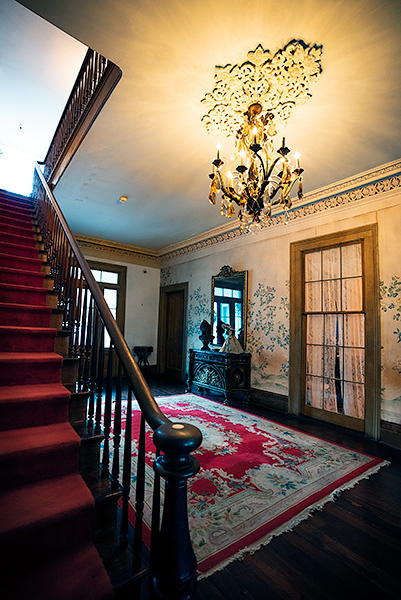
There was clearly no face in the first (horizontal) image. But when I magnified the vertical shot, this is what I saw!

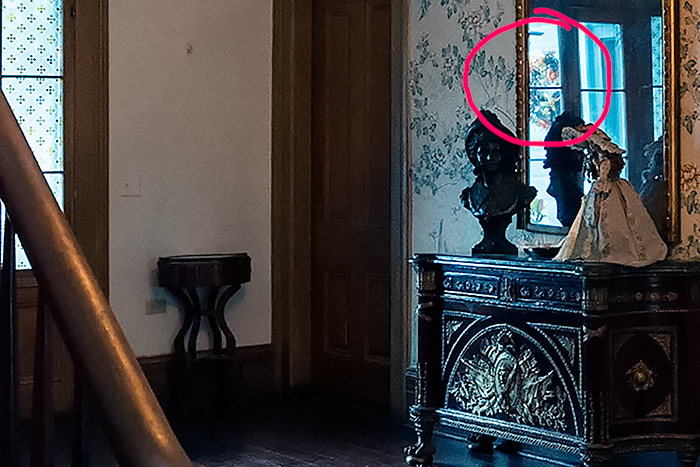
Do you see eyes peeking out of a Mardi Gras mask? Creepy!
Was she a party-goer lingering from the night before? A guest from the phantom dance party that other guests heard? Or was my imagination in overdrive?
French Room
Unlocking the door left of the stairs, our guide led us into the French room. This was Mrs. Stirling’s dayroom where she conducted plantation business, and rested before dinner.

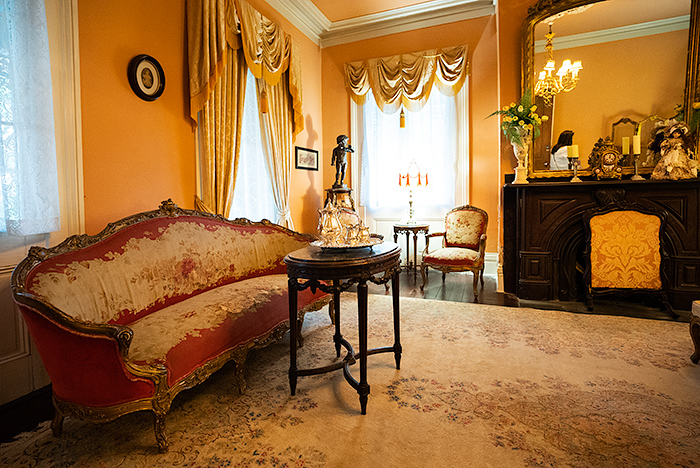
French room
The Stirlings were the 2nd family to inhabit the home. Ruffin and Mary Stirling had amassed great wealth from owning several plantations, and were responsible for adding the expansion on the south end of the home. The addition includes the grand entrance hall, the French room, their masterbedroom suite (Bradford suite guestroom), and the main stairway leading to a large suite where their oldest daughter Sarah and her husband William Winter slept (Woodruff Suite guestroom).
Mrs. Stirling added cherubs to each room to ward off evil spirits. Cherubs also guard each entrance outdoors. She also placed keyholes upside down to confuse spirits and prevent them from entering her home. And she hired artists to hand paint tiny French Gothic Crosses on the French door window panes to ward off evil spirits.
Wonder what ghosts she may have encountered while living here?
The French room is not available as a guestroom. But someone –or something–apparently visits during the night. Guests staying downstairs in the adjacent Bradford suite (accessed from the back verandah) often hear heavy furniture being dragged and moved around. Note the many scratches on the wooden floor.

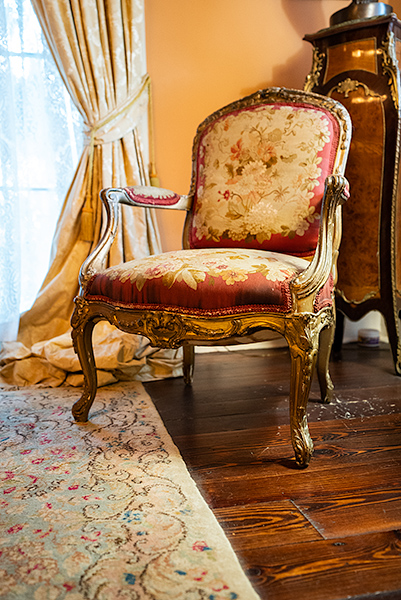
The original owner, David Bradford, purchased the 250 acre property in 1794. He built a simple house for his family of 8 to live in (Gift Shop & reception area today) while he built the plantation mansion which he finished in 1796.
Bradford’s mansion was called Laurel Grove. Their home consisted of the twin parlors, dining room and game room downstairs that you see on the tour, plus 4 bedrooms upstairs that overnight guests access by a staircase leading from the back verandah.
Dining Room
The table is set with china and glassware. The Chinese Chippendale table, dating from the 1850’s, illustrates a typical dinner party from that era.

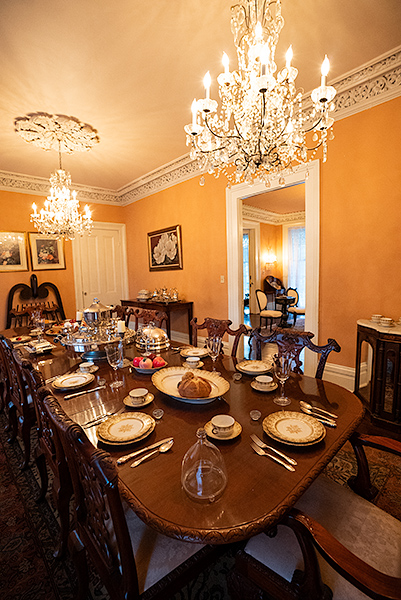
Back in the day, ladies checked the angled mirror on the Petticoat buffet to make sure their skirts reached the floor. And the gentlemen stood to eat at the Hunter’s buffet if they had saddle sores from riding too long on their horses. The glass domed-shaped dish on the table caught flies and was ever-present at meals.
Standing in this room, the guide tells the story of Chloe serving poisoned birthday cake to Sarah and her children so she could nurse them back to health. With a freshly severed ear, she wanted to secure her place in the household after angering her master. But the experimental amount of toxic pulverized leaves was apparently a bit too much…
Ohh, sweet dear, forgive me! Where are my manners? Would you like some cake?
Twin Parlors
Ladies and gentlemen had separate parlors. Pocket doors could close off the twin parlors, if gentlemen needed to conduct private business affairs. Otherwise they were kept open and provided a large space to host parties and weddings. Windows had an usual feature. Built floor to ceiling, the windows could lifted completely, allowing party-goers to dance right through the openings onto the long 125 foot verandah.

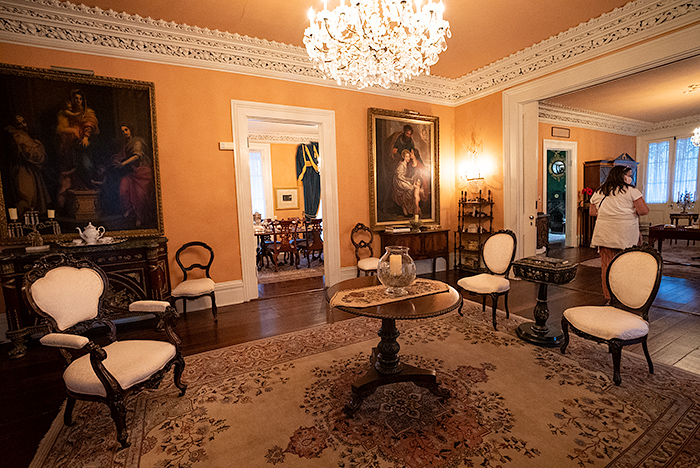
Ladies’ Parlor
Listening to stories about the previous owners, I noticed our guide was increasingly nervous. Her wide eyes darted around the parlor as she recited legends peppered with facts. Donna pulled out her phone and began recording. “Theyr’e here,” she said, capturing 3 orbs (invisible in person) zooming around the room.
The creepiest part of the tour for me were the cherubs in every room, from marble statues to lighting adornments. Even our guide admitted that she can’t look in the corner of the gentleman’s parlor. Too many gasping guests have witnessed watching the cherub’s head move. Whaaat?

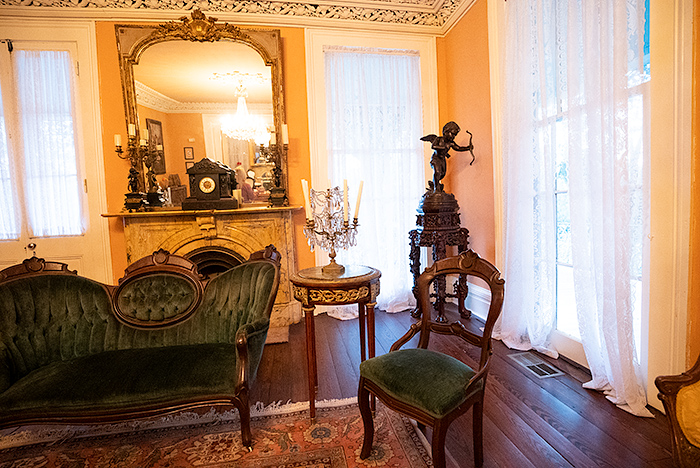
This cherub reportedly moves directions in the Gentlemen’s Parlor.
William Winters was shot on verandah beyond the door (behind couch) of this room. He’d been tutoring his young sons in their school lessons when someone on horseback came galloping up and called out for a lawyer.
Game Room
Many generations spent leisure time here. Men played cards, families played games and played music in this part of the original home.

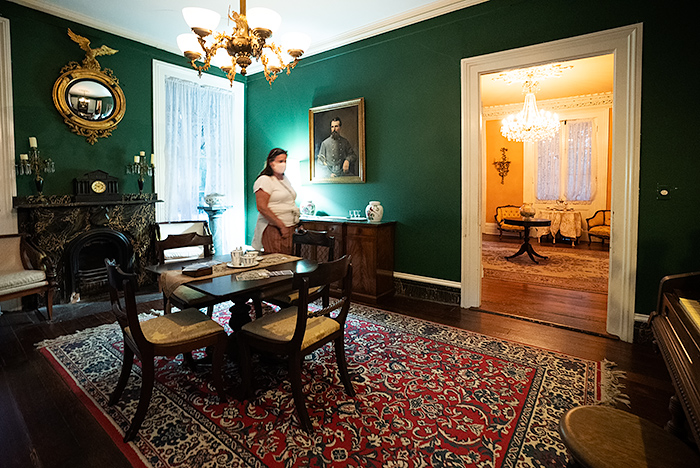
Game Room
A portrait of early owner David Bradford hanging above the organ in the Green Room seemed especially creepy. Maybe because I was remembering all the really scary things that happened to previous ower Frances Keerman here, according to her book.

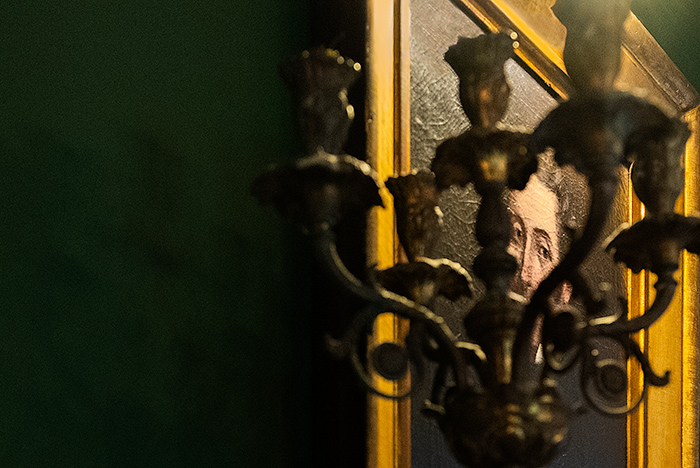
The Green Room is is the last stop on the tour.
Our guide asked us to please stay with her while she turned out the lights and locked up the rooms as we retraced our route to the entrance hall.
She admitted that she’s afraid to be by herself in the home. Twice, she confided, when she was alone locking up, she felt a choke hold around her throat so tight that it immobilized her speechless and motionless. Seriously?
“Honest!!” she said, raising her hand in the air.
I thought she might be joking. But her wide eyes looked sincere, and her voice was laced with fear.

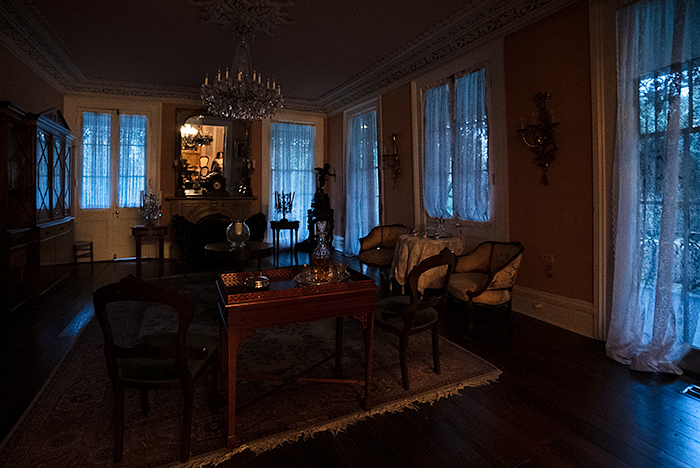
Parting ways on the back verandah, our guide left for home.
Darkness quickly descended. With it came a sense of foreboding. And isolation. Guests had disappeared to their respective rooms. The Gift Shop had closed after the last tour, when remaining staff leaves for the day. Even the onsite 1796 restaurant, open for dinner four nights a week, was closed. The entire property was so eerily quiet. Felt a little spooky.
We drove into town to dine at the fabulous Petra Cafe and feasted on Lebanese food. Then made our way back to Myrtles. Driving up the winding entrance, we passed under the canopy of oaks. Gnarled branches draped with long bearded moss cast shadows in the moonlight. How sinister they looked in the dark!

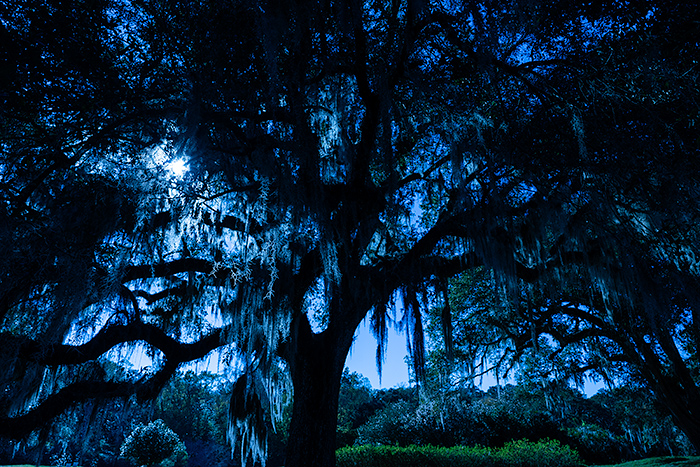
Our experience in the Caretaker’s Quarters
This cottage sits adjacent to the plantation mansion, behind the Gift Shop building. Long time owners, John and Teeta Moss, tore down the original cabin that sat here uninhabited after the caretaker living there was robbed and murdered in 1927.
They built this cabin using wood from 3 slave shacks from neighboring plantations. And added an authentic 210 year-old wooden fence to enclose the inviting cabin and covered porch.
Inside, the furnishings are bright and modern. Guests have two queen beds, a long bench, closet and private bath in the back.

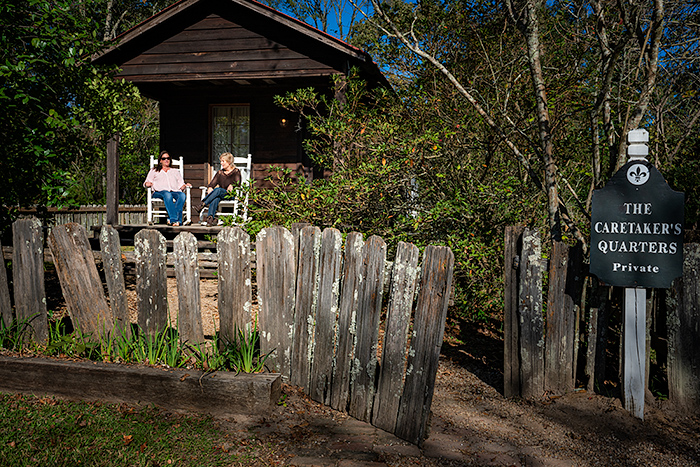
It did not feel scary in the least.
But darkness has a way of playing with your imagination. And heightening your senses. It seemed more isolated when we returned from dinner that night.
See one of the rocking chairs move on its own here.

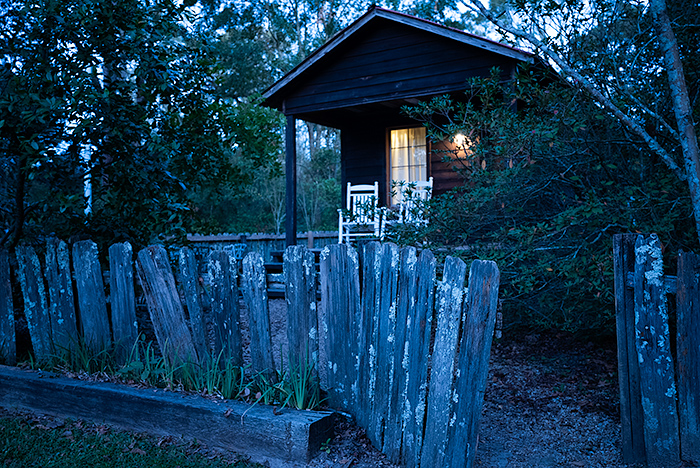
While I was unpacking, my friend changed into her pjs, took out her divining rods, and sat on her bed. Casually, she asked aloud if anyone was here. I looked up surprised.
She wanted to know if there were any spirits present who wanted to talk with her. I knew she was gifted and experienced communicating with spirits, but I had never witnessed her using the rods before. I sat down to watch. She clearly stated her intent and asked the spirits to move the rods out to the sides if the answer was yes, and to cross in front of her for no.
Curious, but admittedly nervous just watching, I had every intention of remaining an invisible bystander.
But whoever was in our presence apparently wanted my attention. When Donna asked a question, only one of the two rods moved… and pointed in my direction. “No, you need to move both,” she reprimanded aloud.
She reset the rods and asked another question. Again, one rod moved…and pointed to me. What the heck!?
Uncomfortable, I immediately moved from the head of my bed to the foot of the bed to distance myself from the rods. And yet a third time, the same single rod slowly and deliberately moved and pointed to me. Seeing the panic in my eyes, Donna burst out laughing. “That’s hilarious, I’ve never seen that before!“ she said, putting the rods away. Well, I didn’t think it was funny. It freaked me out.
Nighty Night
In the middle of the night, I awoke at 3:40am and got up to pee. I was well aware it was the bewitching hour. My camera was set up on a tripod ready to go. I hit play and recorded video at a super high ISO. Nothing captured. After awhile, I turned my camera off.
Returning to bed, I laid awake feeling uneasy. I tried not to think of that rod pointing at me earlier. I closed my eyes and tried to relax. Suddenly, I heard Clink, clink, clink, the sound of metal clanging.
My eyes popped open. “What was that?!” I asked aloud.
Donna, motionless in her bed, muttered, “Probably my rods.” I let that sink in.
“Well, that’s weird!” I replied, waiting for her response. But she already fast asleep and softly snoring. I dove under my covers and stayed there till morning.
Morning
At breakfast, the hostess asked us if we had any experiences to report. Donna shook her head no. I could tell she was disappointed, and probably a little miffed at me that we weren’t staying in the main house where most of the action occurs.
“Well, maybe tonight will be different,” the hostess said cheerfully. “Many guests staying in that cottage report being tickled in their sleep or having their covers pulled off,” she said, describing other pranks that occur from misplaced objects to finding random things in their suitcase.
Waiting for the hostess to wander to another table, I leaned in and whispered. “Don’t you remember that noise last night?” Donna shook her head no. I filled her in.
“Well, I did find it strange this morning,” Donna said matter-of-factly, “that when I got up, one of my rods was missing. I found it on the floor. And it was pointing at you.”
Whaaat?!!
Shivers shot up my arms. My thoughts raced. If I’d heard the clinking noises, why not the thud of hitting the wooden floor?
She calmly took a bite of a freshly made biscuit, and didn’t say another word about it.
Touring St. Francisville
After breakfast, we spent the day exploring the area. We toured Rosedown plantation, just 5 minutes away. The canopied entrance reminded me of Oak Alley.

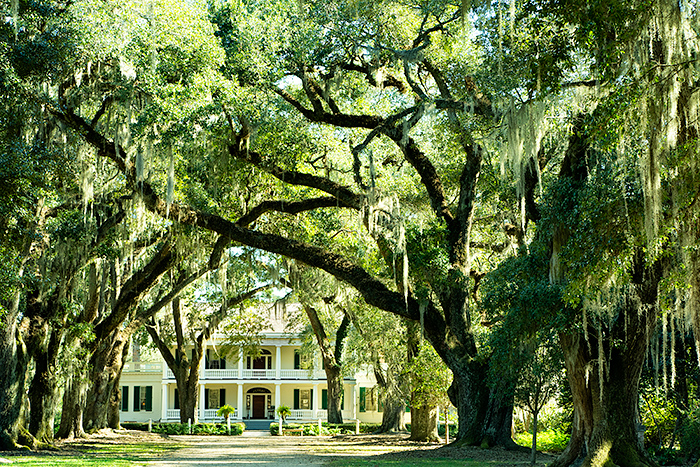
Rosedown Plantation, built in 1834 by Daniel Turnbull one of America’s wealthiest families

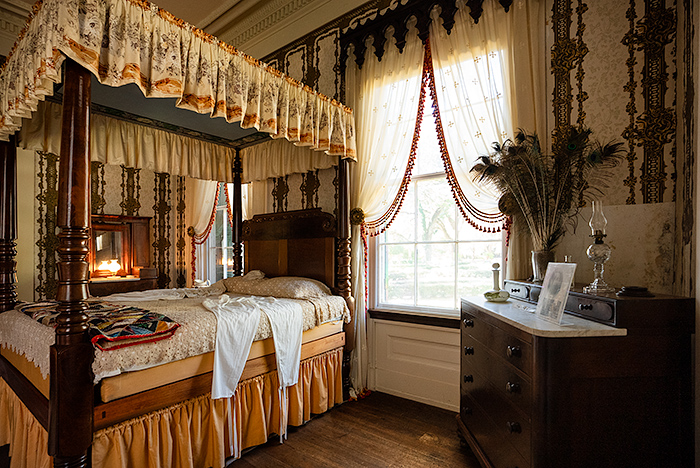
Bedroom at Rosedown Plantation
Then we took a long drive in the country to find other plantations (unfortunately all closed) and shopped around town. Grandma’s Buttons was a special find. We also visited the local cemetery to find the graves of the previous owners. Ruffin and Mary Stirling, their daughter Sarah and her husband William Winters, are all buried at Grace Episcopal Church.

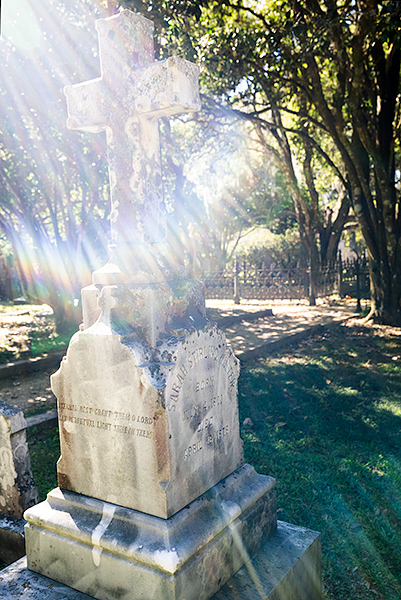
Sarah Winter’s grave in St. Francisville
Later that night, we joined the Mystery Tour before dining at the scrumptious 1796 restaurant. The tour drew a large crowd of 30, mostly families. Our animated, costumed guide retold the same stories that we’d heard the afternoon before, but added more facts in her polished well-rehearsed spin. She did her best to keep our attention. But the addition of so many people crammed into the rooms made the space feel stuffy and hot. Children were restless and fidgety. A couple people left.
It was certainly a different experience than our ‘private’ tour with a guide who inadvertently showed her raw emotions and open fear when leading us around and revealing her personal hauntings inside Myrtle Plantation.

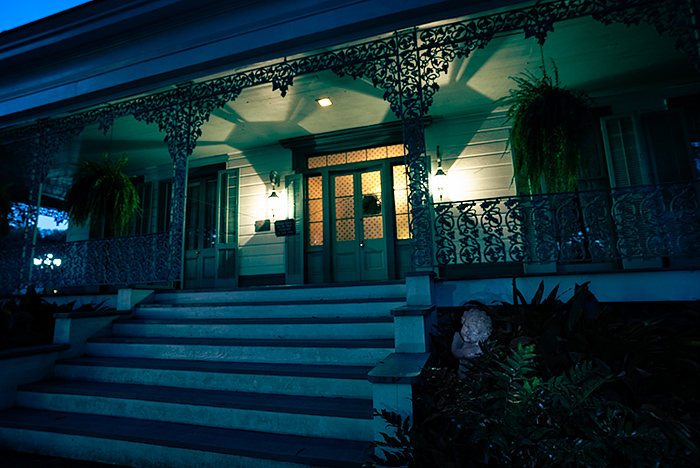
Cherubs guard the entrances at Myrtles Plantation
Around 10pm, Donna and I walked around to the front of the mansion. Nobody else was out there. Spent time taking video. Standing out there in the dark, surrounded by mossy live oaks, we looked for any movement in the house. Staring at so many windows with parted curtains was unnerving. Any little movement caught my eye. Sudden gusts of wind sent shadowy moss into action, like an extended arm reaching out. Hanging ferns swayed, erratically. The motions intensified my nerves. The atmosphere grew eerier the longer we stayed. I felt spooked.
Back in our room, I immediately locked up my camera. I had fully intended to video the entire night. But—can’t explain it without sounding silly—I didn’t want to anger any potential spirits lurking around. Or chance them destroying my gear.
That night, I awoke at exactly 3:40am. Again! But went right back to sleep with the covers over my head. And am happy to report that no ghosts pulled them off.

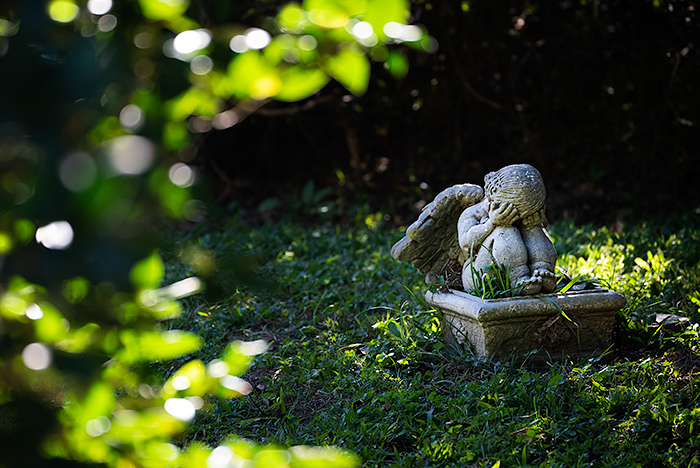
Early History of Myrtles Plantation
The two prominent families who shaped Myrtles Plantation, Bradfords and Stirlings, both had a daughter named Sarah. Both Sarah’s married attorneys who died on the property. This can be confusing. So here’s the history…
Bradfords
David Bradford, a prominent attorney from Pennsylvania, purchased 650 acres near St. Francisville in 1794. He and his wife Elizabeth had 5 young children when they arrived in Lousiana. They first lived in the clapboard house that still houses the kitchen today in addition to a Gift Shop and breakfast area. He finished building the plantation mansion in 1796, which he called Laurel Grove. They planted indigo and cotton and had 24 slaves. Three additional children were born at the plantation: Eliza, Sarah and Octavia.
When David died in 1808, his wife carried on as overseer of the plantation. Many of her children were married at the plantation, including 19 year-old daughter Sarah Matilda Bradford, who married 26 year-old Clark Woodruff in the Ladies’ parlor on Nov 19, 1817. They had met when he returned from the War of 1812 and set up a law practice in St. Francisville. When they returned from their honeymoon at Hermitage, the home of Clark’s friend Andrew Jackson, the newlyweds moved into Laurel Grove to help 54 year-old Elizabeth manage the plantation.
Woodruffs
Clark Woodruff expanded the crops and increased labor to 450 field hands plus 30 house servants.
Clark and Sarah had twins, James and Cornelia, and a daughter named Mary. As was common during that time period, slaves were entrusted in the upbringing of the children. One of the legends and ghost sightings is that of a young slave girl named Chloe. According to the story, she was caught eavesdropping by her master Clark Woodruff and promptly punished by having her ear cut off. Fearing that she would lose her coveted position in the household, away from the children she loved so much, she devised a plan to secure her position. While baking the twin’s birthday cake, she added crushed up oleander leaves, knowing it would make them sick, so that she could then nurse them back to health.
Tour guides claim that Chloe poisoned the twins and their mother Sarah, who all swiftly died. But in reality, if there is an inkling of truth to the tale, they all recovered. Sarah died from yellow fever in 1823 at the age of 25. Her twins also died from the dreadful disease a year later–first son James, then 2 months later, Cornelia. You can see their graves at Grace church cemetery.
When Clark’s mother-in-law Elizabeth died in 1830, he decided to leave Laurel Grove with his only surviving daughter, Mary. He left the management of the plantation to a caretaker and become a judge in Covington, Louisiana. He sold the plantation to Ruffin and Mary Stirling in 1834 for $46,853.00.

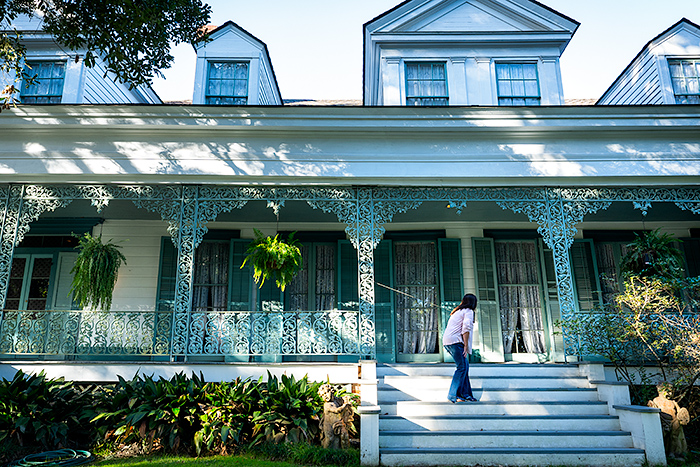
Stirlings
Ruffin and Mary Stirling were wealthy landowners from North Carolina. They spent several years renovating their new plantation home, adding an entire wing that includes the grand entrance hall, French room, and master suite downstairs plus another staircase that led to a large bedroom suite and sitting area upstairs. The couple traveled throughout Europe to collect furnishings for their home to create a showpiece to host lavish parties. Mary hired French craftsmen to hand paint French crosses on the entrance doors, carve ceiling medallions and friezes, and to create the elaborate mint-green grillwork on the 125 foot verandah. Stirlings renamed their mansion, Myrtles Plantation, when final decorating touches were completed in the 1850’s.
Only one of their 9 children were born at the Myrtles, Mary Ann. Tragically, 4 children died before they reached adulthood. Ruffin died in 1854, leaving his 41 year-old wife to run the plantation operation just like the previous owner, Elizabeth Bradford, had done. Except Mary Stirling had 4 plantations to oversee.
Winters
The oldest Stirling daughter, Sarah Mulford, married William Winters when she was 19. He was a prominent attorney. Their ‘Wedding of the Decade’ on June 3, 1852 took place in the Ladies Parlor at the Myrtles. They lived on William’s plantation near Clinton, Louisiana, then moved to a plantation near West Baton Rouge. They had four children.
When their 3 year-old daughter, Kate, developed typhoid fever in 1861, she was taken to the Myrtles, perhaps to prevent spreading the disease to her siblings. Desperate to save their dying daughter, they enlisted the help of Cleo, a Voodoo priestess from a neighboring plantation. But despite the intervention their little girl died.
When the Civil War broke out, soldiers looted plantations, including the Myrtles. During the time, Mary Stirling hid a wounded Conferate soldier upstairs for a couple months until a nearby plantation owner turned him in. When the war ended in 1864, slavery was abolished and plantations were left without their field hands. Defeated by destroyed crops, Mary reached out for help. She offered to give the Myrtles to her daughter Sarah and son-in-law William if they would help salvage the plantations.
They agreed, and moved into Myrtles Plantation in December 1865. They slept upstairs (Woodruff guestroom) where Sarah was raised. Son, Francis, was born June 1867. Six months later, the debt was too great and the Winters filed for bankruptcy. Myrtles was sold by the US Marshall in April, but 8 days later the plantation reverted back to Sarah as being the rightful Stirling heir. Together with Sarah’s mother, the couple moved back home and continued farming the land despite financial struggles. Their five children grew up healthy and happy.
Mr. Winter’s Murder
On Jan 26, 1871, around 7pm, William was in the gentleman’s parlor teaching school lessons to his 9 and 13 year-old sons. Suddenly, they could hear a horse galloping up to the north verandah and a voice demanding to see a lawyer. Mr. Winters opened the parlor doors to step outside into the dark night. The man on horseback asked his name, then shot William in the chest before riding off. His assailant was never caught, although newspaper articles attributed the violence to racial tensions that ensued in the Reconstruction era following the war.
Mr. Winters died from the gunshot wounds and was buried at Grace church cemetery the next day. According to the legend surrounding his murder, the story goes that William staggered through the parlors and crept up the main stairs to seek solace from his wife. As he reached the 17th step, he died in his wife’s arms.
Stricken with grief, Sarah became a recluse and stayed in her bedroom. Not even her 4 year-old son, her teenage sons or daughters could convince her to come out. She died seven years later, in April 1878. And her mother, Mary Stirling, died 2 years later.
Last of the Stirlings
Mary’s son Stephen Stirling then purchased the Myrtles Plantation with his wife Amanda. They had 2 little blond girls, Nannie and Maud, aged 3 and 1. For 5 years the young family struggled to earn a profit, and sadly had to sell the family property in 1886.
After 50 years, the Stirling family, who had expanded the mansion and spared no expense decorating it, were no longer owners of Myrtles Plantation ever again.

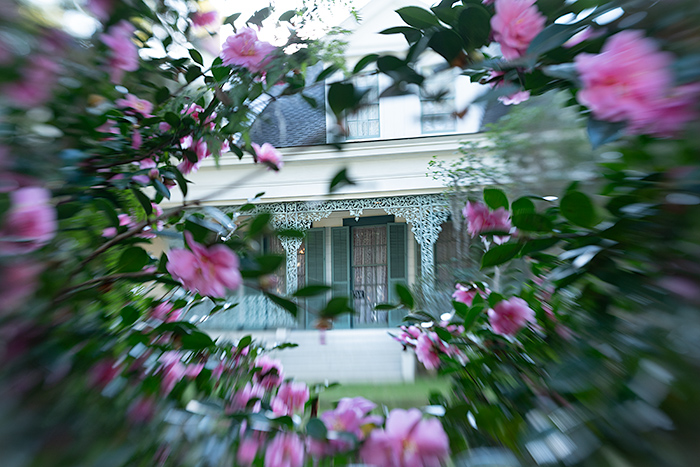
Ghosts at Myrtles Plantation
Chloe – the young slave girl who poisoned Sarah Bradford Woodruff and her twins. Although previous owners Marjorie Munson and Frances Keerman saw an older matronly black woman (not a 14 year old girl) wearing a green gown and turban who tucked people in. Current owner Teeta Moss captured a photo of Chloe standing between the main house and the Gift Shop building in 1992. Sightings of Chloe have been reported for over 100 years. Previous owner Marjorie Munson wrote a song about this ghost. She hired Mr. Michaud, a composer, who ended up marrying her and moving into the Myrtles where they held music recitals in the 1950’s. Not confined to any particular room, Chloe wanders freely.
Mr. Winters – the lawyer who was shot on his verandah haunts the main staircase with loud footsteps that often stop on the 17th stair where he died.
Sarah Winters – seen in a black gown and veil, standing on the main staircase, or wandering rooms around the house looking for something. Often heard sobbing.
2 blond girls – curly ringlets, pinafore dresses, happy children curiously peeking in windows, tugging on guest clothes or following guests around. They may be the last of the Stirling children to live at Myrtles. Young blond sisters, Nannie and Maud, lived here 5 years from 1881-1886.
Caretaker – a gruff man wearing overalls and a straw hat has been seen at the entrance of the property telling tourists to leave Myrtles Plantation. It is believed that he was the man murdered during a robbery in his cabin where the Caretaker’s Quarters sit. He has been seen looking out the window of the cottage.
Cleo, Voodoo priestess – the woman who attempted to restore the health of dying Kate, the 3 year-old daughter of Sarah and William Winters. She lived on a neighboring plantation.
Crying infants – many children died at the Myrtles from yellow or typhoid fever.
Dancing woman – seen in the French room, she floats a few feet off the floor in a black dress. Some believe she is Marjorie Munson.
Small black children – seen outdoors by visiting children who tend to run off to play with them.
Confederate soldier – a wounded soldier lived upstairs of the main house for 2 months during the Civil War.
Who would you want to see?

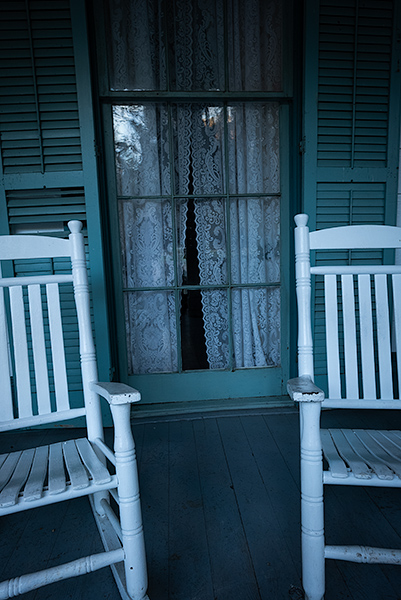
Other Random Occurrences
Phantom party noises, doors banging shut, lights turning on or off, tapping on windows, laughter, crying, rattling doorknobs, tickling, being poked, voices calling your name, orbs, piano music, swaying chandeliers, icy temperatures, knocking, sounds of heavy furniture being dragged across the wooden floor, whistling, floating beds, pillows or sheets being yanked away, clothes rearranged during your absence, single earrings disappearing, camera equipment malfunctioning, electronics not working, rocking chairs moving on their own, smells of perfume or cigars, or the caretaker shooing people away.
Rebecca Pittman also wrote a book, The History & Haunting of the Myrtles Plantation, released in 2016. In it, she includes a thorough history of the property, facts gleaned from interviewing current and previous owners, and guest experiences–including her own. A good read for those who want a hefty historical background plus hauntings.
Haunted Guestrooms at Myrtles Plantation
There are 6 guestrooms inside the antebellum mansion. Five are upstairs. The living areas downstairs are kept locked. Guests can’t roam around the house at night. Only the ghosts!
Guestroom names are a bit confusing– the rooms do not match up with the residents who once slept there. Important to know if you’re hoping for a particular experience.

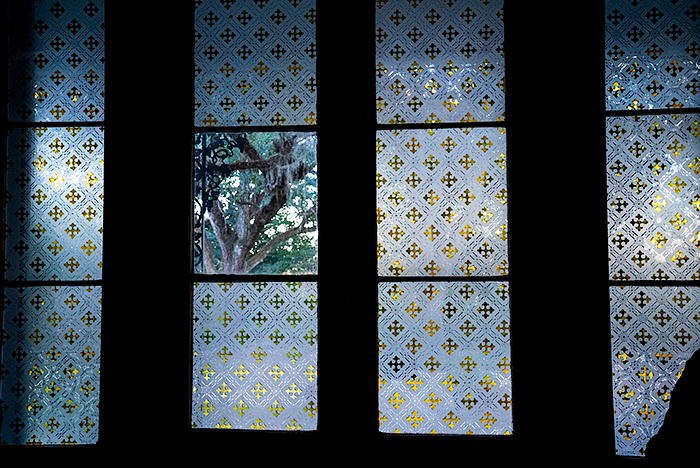
Gothic French Crosses hand-painted on the panes warded off evil spirits
Stirling addition:
Woodruff Suite – where Sarah and William Winters slept upstairs. And where Sarah stayed as a recluse for 7 years until she died from depression after her husband was murdered. Guests report hearing footsteps ascend the main staircase at night, hear Sarah sobbing or calling out “Help me!”
Room access: a key unlocks a door on the back verandah to the grand entrance hall. Walk past the haunted mirror and locked Ladies’ parlor, then up the staircase (where Winters died) to reach the largest and grandest suite in the home. Nobody else has access to this grand hallway. Or stairway. You are all alone. This is the most isolated place to stay inside the main house. Are you good with that?!
Bradford Suite – where Ruffin and Elizabeth Stirling slept downstairs. And later, innkeeper/author Frances Keerman and her husband Jim. Guests report hearing the footsteps ascend the main staircase, and heavy furniture moving around around them.
Room access is through a direct door on the back verandah. (There’s a door to the grand hallway behind the piano across from the haunted mirror but it remains locked.)

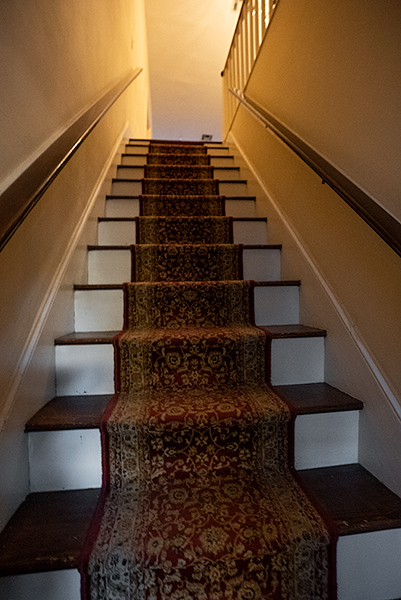
Back staircase leading to 4 guestrooms in the original home
Original Bradford home:
Room access: a key unlocks a door on the back verandah to the stairs leading to the upstairs suites. These 4 guestrooms of the original house share a small sitting area.
Ruffin Stirling Suite – former children’s nursery upstairs. Room where many children slept, and died from yellow fever, including the Woodruff twins. Guests report hearing infants crying, adults sobbing, fists pounding on the closet door and feeling the sheets tighten as if being tucked in. Toiletries often go missing. Perhaps the most frightening experience is the bed being shaken while your’e sleeping (look at gauges in the floor).
William Winters Suite – this is the 2nd half of the original nursery upstairs, where 3 year-old Kate Winters died. Guests report hearing heartwrenching sobs and seeing a rag doll hanging from the chandelier. Voodoo priestess sometimes seen. One of the more active rooms.
Fannie Williams Suite – named for the 25 year-old wife of Harrison who bought the Myrtles in 1897 and raised 7 children here. Either David and Elizabeth Bradford (the original owners), or their daughter Sarah and Clark Woodruff slept here. Or the John Leake room– as the other 2 rooms were the nursery. Sarah died from yellow fever at age 25 in her bedroom. Also known as the Doll’s Room. Guests report the dolls moving.
John Leake room – May and June is peak activity as this is when a Conferate soldier lived in this room. Guests may have vivid war dreams, see a uniform hanging in the closet, see a soldier resting in bed with his leg elevated, hear him “Shhhhing” guests, or even feel the sensation of being pressed on their chests.

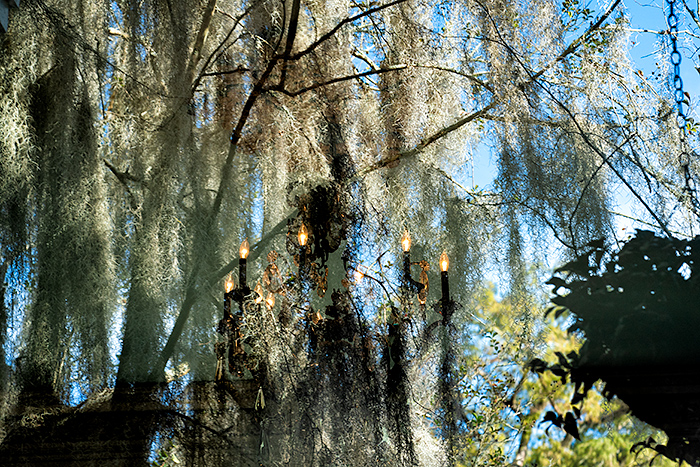
Cottages on the property
According to paranormal investigators, ghosts tend to repeat actions in the same place. But Spirits can move all around. So it’s no surprise that guests staying in the cottages scattered around the property also report strange encounters. Guests hear voices, tapping on windows, and drumming coming from the woods. Slaves once lived near here. Slaves used drums to communicate with friends at neighboring plantations and during voodoo rituals.
Check TripAdvisor for guest reports about hauntings in specific cabins.

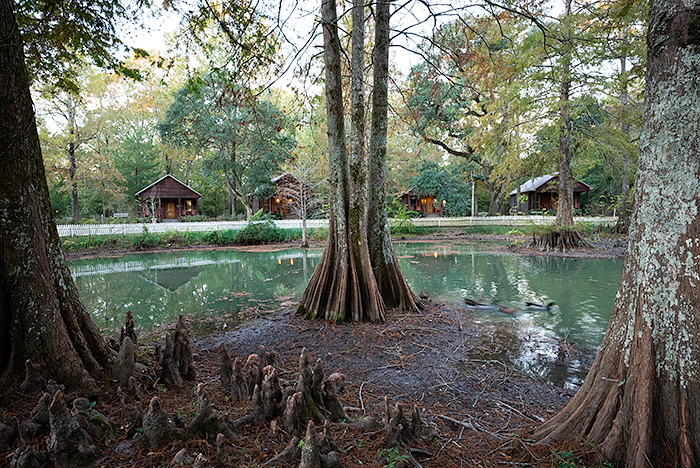
Cottages beyond the cypress pond
A wooden bridge crosses to this tiny island in the middle of the cypress pond. And a path leads to a gazebo.

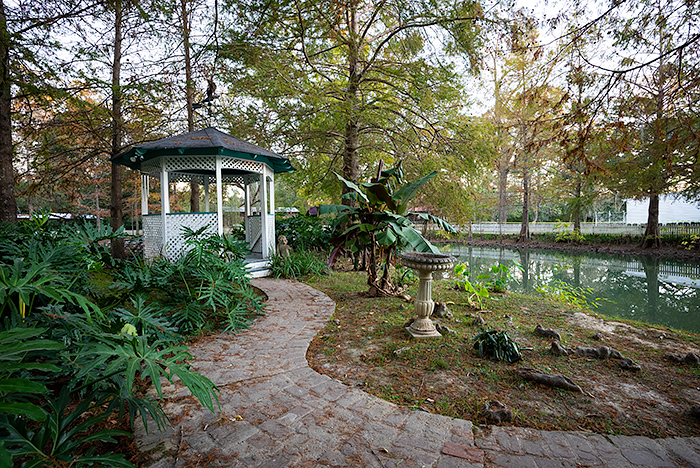
Want the least scary room? Book a Garden Room. Built in the 80’s, these newest rooms are the least haunted. Located next to the restaurant, these contemporary rooms face the courtyard across from the Gift Shop/Reception.

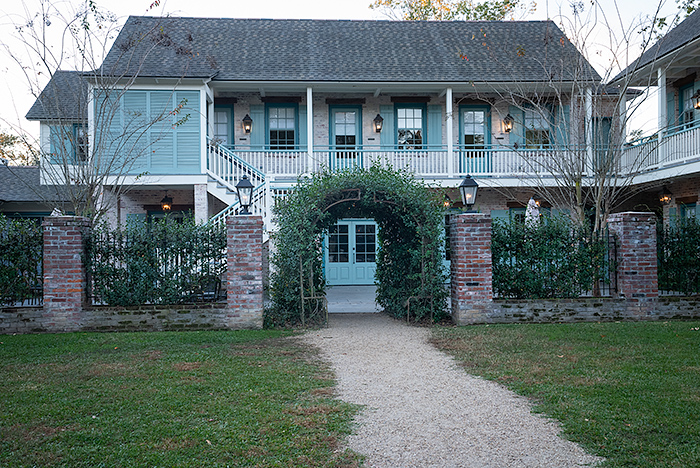 Breakfast is included for all guests in the Gift Shop/Reception building. Or sit outside. (Backside of mansion on left, restaurant on right.)
Breakfast is included for all guests in the Gift Shop/Reception building. Or sit outside. (Backside of mansion on left, restaurant on right.)

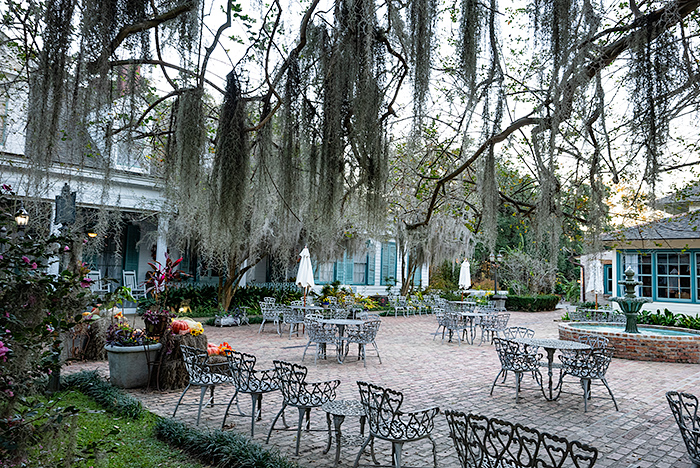
Location of Myrtles Plantation
The plantation inn is in St. Francisville, a quaint town located 26 miles north of Baton Rouge, 98 miles north of New Orleans, or 87 miles east of Lafayette, Louisiana. There are many other plantations to tour in the area, making it a great destination for a 2-3 night stay.

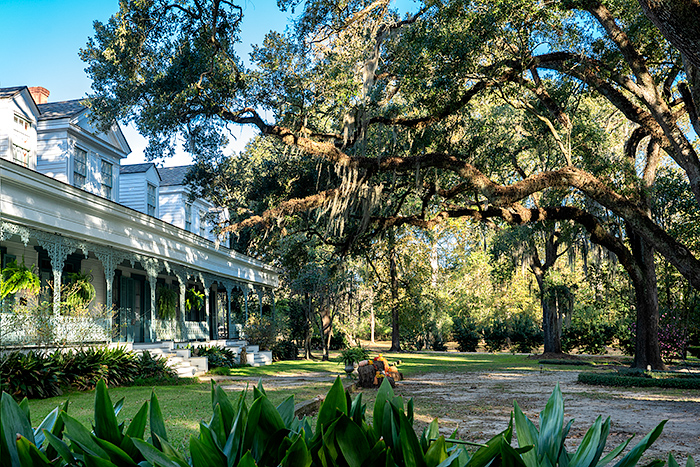
Lodging Tips
The 1796 Restaurant is open for dinner 4 nights a week, Wednesday through Saturday. The menu features Southern-inspired cuisine cooked on an open hearth. On Wednesday and Thursday, a five course Chef’s Tasting Menu from their seasonal menu is available for $50.00 per person, and $20 more for wine pairings. Reserve in advance. Lunch is available Friday to Sunday.
This is a popular place! Book your guestroom months in advance, especially rooms in the main house. Even the cottages can be difficult to reserve. Check out the Myrtles Plantation website for photos of the individual rooms available for your dates.
The evening Mystery Tour is an hour long tour of the downstairs rooms of the mansion. Offered Wed-Sat at 6pm, 7pm or 8pm. Tickets are $15.

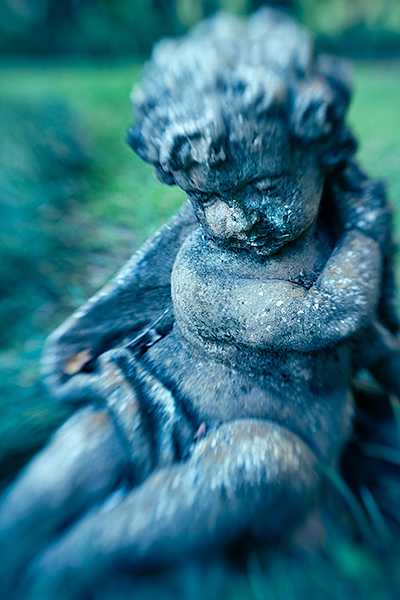
Staying overnight at the Myrtles Plantation is a completely different experience than visiting during the day.
Just be prepared for the possibility to be rattled awake… by whispers, footsteps, music, knocking, falling objects or even a moving bed.
Sweet dreams!
Map of the area:
[booking_product_helper shortname=”st. francisville”]
Save a Pin to your Pinterest board for later!


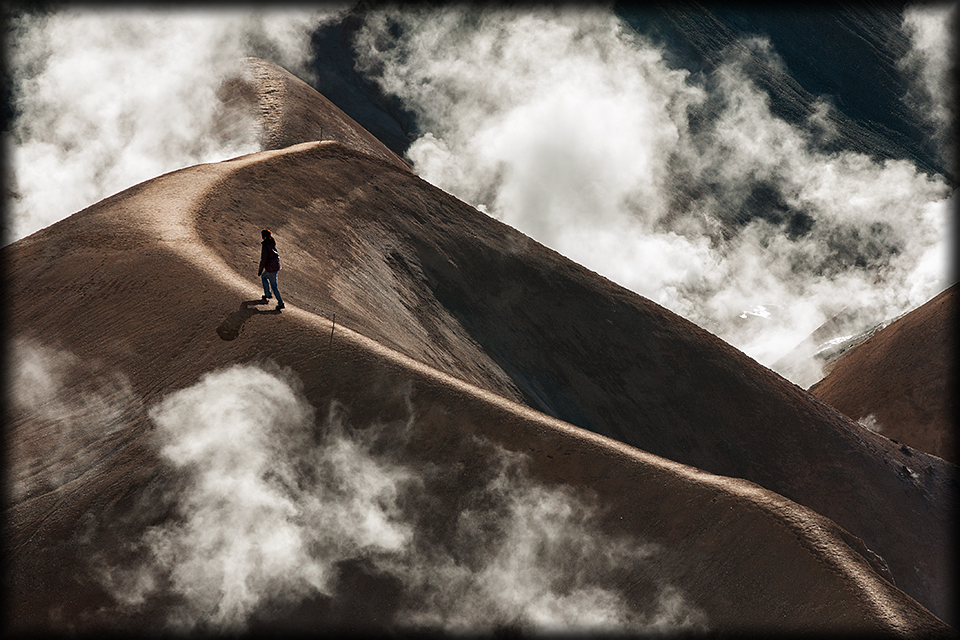
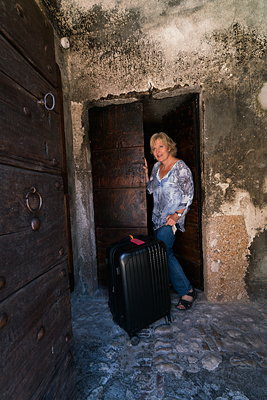
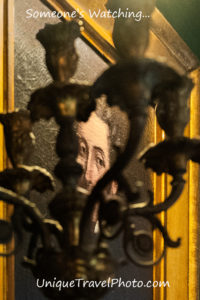
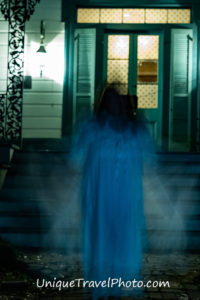
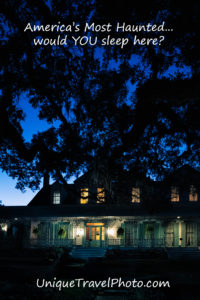
Promocodeshub - Thank you for sharing road tips and it is very much helpful to me.
Charles brown - We would like to stay the night in the plantation home
Kim Walker - Which room would you pick?!